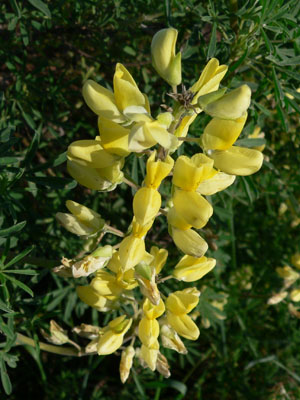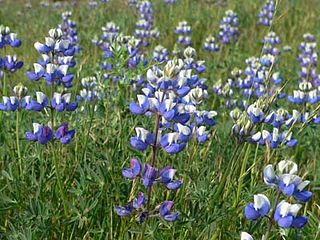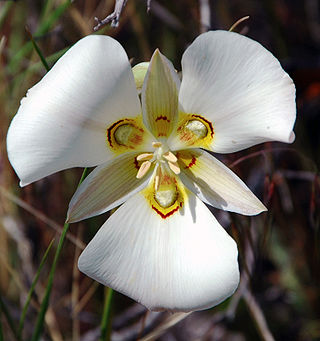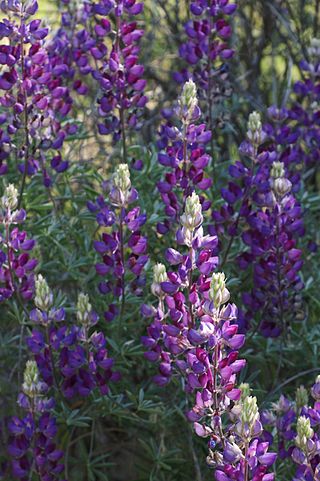
Lupinus polyphyllus, the large-leaved lupine, big-leaved lupine, many-leaved lupine, blue-pod lupine, or, primarily in cultivation, garden lupin, is a species of lupine (lupin) native to western North America from southern Alaska and British Columbia and western Wyoming, and south to Utah and California. It commonly grows along streams and creeks, preferring moist habitats.

Lupinus, commonly known as lupin, lupine, or regionally bluebonnet etc., is a genus of plants in the legume family Fabaceae. The genus includes over 199 species, with centers of diversity in North and South America. Smaller centers occur in North Africa and the Mediterranean. They are widely cultivated, both as a food source and as ornamental plants, but are invasive to some areas.

Lupinus arboreus, the yellow bush lupine (US) or tree lupin (UK), is a species of flowering plant in the legume family Fabaceae.

Lupinus diffusus, commonly known as Oak Ridge lupine, spreading lupine, or sky-blue lupine, is a species of lupine native to the southeastern United States, from North Carolina south to Florida and west to Mississippi. It is restricted to very dry, sandy soils, often in open pine or oak woodlands.

Lupinus arizonicus, the Arizona lupine, is a flowering plant in the legume family Fabaceae, native to the Mojave and Sonoran Deserts of North America, where it can be found growing in open places and sandy washes below 1,100 metres (3,600 ft) elevation. It is common around Joshua Tree National Park and Death Valley National Park in California.

Lupinus texensis, the Texas bluebonnet or Texas lupine is a species of lupine found in Texas, Louisiana, Arkansas and the Mexican states of Coahuila, Nuevo León, and Tamaulipas. With other related species of lupines also called bluebonnets, it is the state flower of Texas.

Lupinus nanus, the sky lupine, field lupine, dwarf lupin, ocean-blue lupine or Douglas' annual lupine, is a species of lupine native to the western United States. It is found natively in California, Nevada, and on Steens Mountain in eastern Oregon. It tends to grow on slopes and in open or disturbed areas below 1300 meters.
Buffalo clover may refer to:

Calochortus nuttallii, also known as the sego lily, is a bulbous perennial plant that is endemic to the Western United States. The common name of sego comes from a similar Shoshone word. It is the state flower of Utah.

Lupinus perennis is a flowering plant in the family Fabaceae.

Lupinus albifrons, silver lupine, white-leaf bush lupine, or evergreen lupine, is a species of lupine (lupin). It is native to California and Oregon, where it grows along the coast and in dry and open meadows, prairies and forest clearings. It is a member of several plant communities, including coastal sage scrub, chaparral, northern coastal scrub, foothill woodland, and yellow pine forest.

Lupinus havardii is a species of lupine known by the common names Big Bend bluebonnet and Chisos bluebonnet. It is native to Texas and Chihuahua, where it blooms between January and June. Its habitat includes gravelly, fine talus, and the alluvial soils in the desert, valleys, hills, and mountain slopes.

Lupinus brevicaulis is a species of lupine known by the common names shortstem lupine and sand lupine. It is native to the southwestern United States, including Oregon, California, Nevada, Utah, Colorado, Arizona, and New Mexico, where it grows in many types of sandy habitat.

Bluebonnet is a name given to any of a number of purple-flowered or blue-flowered species of the genus Lupinus predominantly found in southwestern United States and is collectively the state flower of Texas. The shape of the petals on the flower resembles the bonnet worn by pioneer women to shield them from the sun. Species often called bluebonnets include:
A blue bonnet is a type of soft woollen hat that was the customary working wear of Scottish labourers and farmers.

Lupinus kuschei, the Yukon lupine, is a species of flowering plant from the order Fabales which can be found in Alaska and Western Canada.
Alamo Fire or Texas Maroon are names given to a maroon hybrid cultivar of Lupinus texensis, Texas' state flower.

Lupinus villosus, commonly known as lady lupine, pink sandhill lupine, or hairy lupine, is a flowering plant species in the genus Lupinus.
Lupinus prunophilus, commonly known as the hairy bigleaf lupine or chokecherry lupin, is a medium-sized herbaceous plant that grows in the Great Basin and other parts of the U.S. interior between the Sierra-Nevada and the Rockies. It is a close relative and very similar to Lupinus polyphyllus and is considered a subspecies by some botanists.

Lupinus caudatus is a widespread species of wildflower in genus Lupinus from western North America known by the common names tailcup lupin and spurred lupin. It is distinctive for the short spur on its purple-blue flowers, for which it is named. Because of its wide distribution and toxicity it commonly causes poisonings of susceptible livestock such as horses, cattle, and sheep, though it is eaten without harm by wild herbivores like deer and elk. It is generally found from the Coastal Ranges and Sierra Nevada Mountains in the west to the Rocky Mountains in the east.
















